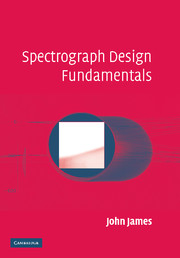Book contents
- Frontmatter
- Contents
- Preface
- Acknowledgements
- 1 A brief history of spectroscopy
- 2 The relevant regions of the electromagnetic spectrum
- 3 Geometrical optics
- 4 Optical aberrations
- 5 Fourier transforms: a brief revision
- 6 Physical optics and diffraction
- 7 The prism spectrograph
- 8 The plane grating spectrograph
- 9 The concave grating spectrograph
- 10 The interference spectrograph
- 11 The multiplex spectrometer
- 12 Detectors
- 13 Auxiliary optics
- 14 Optical design
- 15 Mechanical design and construction
- 16 Calibration
- 17 The alignment of a spectrograph
- Appendix 1 Optical aberrations
- Appendix 2 Wavelengths of spectral lines for calibration
- Appendix 3 The evolution of a Fabry–Perot interference spectrograph
- Appendix 4 The common calibration curve in silver halide spectrophotometry
- Bibliography
- Index
Appendix 4 - The common calibration curve in silver halide spectrophotometry
Published online by Cambridge University Press: 02 September 2009
- Frontmatter
- Contents
- Preface
- Acknowledgements
- 1 A brief history of spectroscopy
- 2 The relevant regions of the electromagnetic spectrum
- 3 Geometrical optics
- 4 Optical aberrations
- 5 Fourier transforms: a brief revision
- 6 Physical optics and diffraction
- 7 The prism spectrograph
- 8 The plane grating spectrograph
- 9 The concave grating spectrograph
- 10 The interference spectrograph
- 11 The multiplex spectrometer
- 12 Detectors
- 13 Auxiliary optics
- 14 Optical design
- 15 Mechanical design and construction
- 16 Calibration
- 17 The alignment of a spectrograph
- Appendix 1 Optical aberrations
- Appendix 2 Wavelengths of spectral lines for calibration
- Appendix 3 The evolution of a Fabry–Perot interference spectrograph
- Appendix 4 The common calibration curve in silver halide spectrophotometry
- Bibliography
- Index
Summary
The problem of photometry with silver halide emulsions is that of finding the relation between density and exposure. Density is defined as minus the logarithm of the transmission ratio, i.e. of the fraction of incident light transmitted through the emulsion to the detector (on the assumption that the response of the detector is linear). Exposure is defined as the product of incident intensity during the photographic exposure and the duration of the exposure, and it is assumed, justifiably, that the density depends only on the product.
The method of the common calibration curve is to take several photographs of the same spectrum under identical circumstances, but with different neutral-density filters, the filter densities ascending for example in factors of 2. The densities of a particular spectrum line, measured from the different exposures, will give a set of points on the calibration curve. A different spectrum line can then be interpolated on this initial line and the different exposures of this second line provide further points which extrapolate the curve at one end or the other. By continuing in this fashion with other spectrum lines, the curve can be continued, always by interpolating new initial material, gradually extending the curve in both directions as far as necessary and well beyond the linear portion.
- Type
- Chapter
- Information
- Spectrograph Design Fundamentals , pp. 186Publisher: Cambridge University PressPrint publication year: 2007



